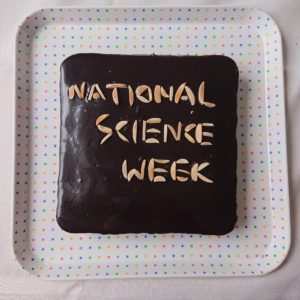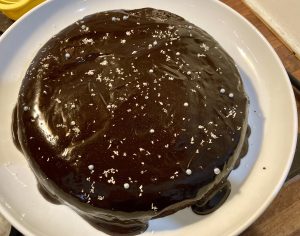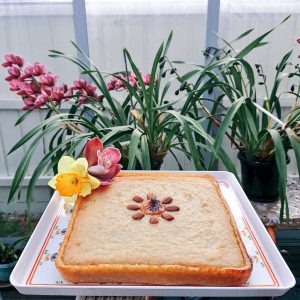The Future of Food: The Possible Impossibles Bake Off


As our climate and environment continues to change, it is inevitable that our diets may need to change to reflect changing food availability. During National Science Week, the Royal Society of Victoria challenged the Victorians to make the impossible possible: to bake treats omitting common baking ingredients that may be scarce in the future.
Several community members rose to the challenge of creating a Science Week morning tea treat without flour, eggs, cane sugar or dairy. From eggless pavlovas and cheese-less cheesecakes, to gluten-free sponges and vegan chocolate cakes – things got quite experimental in the kitchen!
There is a myriad of threats to the global food supply from pathogen infestations in crops and livestock to water shortages and climate change. By 2050, the UN projects that we will have nearly 10 billion people on the planet, which is many more mouths to feed. The Food and Agriculture Organization estimates that we need to increase our food production by about 40% by 2030 and 70% by 2050 to support this population growth. Population growth also eats into good quality farming land as cities spread out.
Agricultural practices themselves can be a threat to the changing climate. Greenhouse gasses methane and nitrous oxides are predominantly produced in agriculture. The agriculture industry also takes up much of our fresh water supply – up to 80 or 90% of the current water supply in some parts of Asia and Africa.
As part of the Possible Impossibles Festival for National Science Week, some common staples were identified as “at risk”, meaning that they may not be so common or cheap in the future… How would you creatively work around shortages of these foods?
Wheat/Grain
Extreme weather conditions, such as heavy rainfall and consequent floods, contribute to severe desert locust outbreaks. Over the past year, massive swarms of desert locusts ate their way through crops in East Africa, up the Arabian Peninsula and into western Asia. Locusts move in swarms of up to 50 million, can travel nearly 150 kilometres a day, and lay as many as 1,000 eggs per square metre of land – a force to be reckoned with. They decimate crops (particularly wheat and cotton) and cause billions of dollars of damage, leading to fears of long-term food shortage. Another major threat to wheat and barley crops is wheat rust, a fungal disease. After destroying 40% of North American crops in the 1950s, it has bounced back with a vengeance in Africa, spreading into the Middle East. If it were to affects major agricultural areas in Australia, Asia or America, the results would be devastating.
Eggs
As more people are concerned for animal welfare and buy free-range eggs, the land required to supply demand will also continue to grow – and farming land is becoming a precious commodity. However, free-range chickens that access outdoor areas are exposed to predators, climate extremes, and influenza from wild birds. The flu, being highly contagious, can infect shed full of birds – around half a million birds. These factors drive up egg prices, especially during an outbreak of bird flu (avian influenza).
Sugar
The sugarcane plant can adapt to different environmental stresses but is vulnerable to frost and extreme weather events, which are becoming more frequent. Temperature stress limits sugarcane plant growth and productivity, therefore reducing the amount of sugar harvested. Sugarcane smut, one of the most serious diseases of sugarcane, is also likely to increase under high temperature conditions. Discovered for the first time in Western Australia, smut is now a threat to crops in all regions of the Australian sugar industry.
Dairy
A study by Dairy Australia in 2015 revealed that the dairy industry accounted for around 10% of agricultural greenhouse gas emissions in the form of methane. The good news, however, is that cows on a higher quality diet produce less methane. But with a growing population to feed and house, adequate grazing land is becoming a precious commodity. In addition, water scarcity linked to the changing climate will also impact the industry by reducing the amount of water available for animal drinking, crops, and product processing. Together with a predicted doubling or tripling of animal water consumption due to global warming, this may translate to reduced herd numbers and less milk for us.
The Winners
Congratulations to the two winners of the Bake Off Challenge! Both submitted photos of their very creative entries. If you would like to try recreating these treats, you can find recipes on the Inspiring Victoria website.
Tanya Ha

Tanya took the science to the next level with a Pleiades astro-themed cake. The chocolate cake featured the Seven Sisters of the Taurus Constellation in honour of the superstar women in STEM that Tanya has the pleasure of working with. The cake was comprised of a mix of corn, buckwheat and brown rice flour, coconut sugar, and stevia.
All the ingredients ultimately came from the stars, as their atoms were made of stardust. Most chemical elements are created in the cores of stars. Only the lightest of elements (hydrogen, helium and lithium) were created as a result of the Big Bang and the rest are made during the life or death of stars.
Suong Nguyen
 Many Vietnamese foods are naturally gluten-free and/or vegan. Suong therefore decided to whip up a treat from her childhood for the bake off. Her cassava cake (bánh khoai mì nướng) is made from three ingredients: grated cassava, coconut milk and palm sugar. Cassava is a starchy root vegetable, similar to sweet potatoes and the source of tapioca flour. Unlike light, fluffy and crumbly Western cakes, many Asian cakes such as this are dense, sticky and chewy because most cakes were traditionally steamed rather than baked (although this one has been in the oven). This cake is an excellent example of how diversity and the bringing together of different cultures and ideas can help in the face of global challenges.
Many Vietnamese foods are naturally gluten-free and/or vegan. Suong therefore decided to whip up a treat from her childhood for the bake off. Her cassava cake (bánh khoai mì nướng) is made from three ingredients: grated cassava, coconut milk and palm sugar. Cassava is a starchy root vegetable, similar to sweet potatoes and the source of tapioca flour. Unlike light, fluffy and crumbly Western cakes, many Asian cakes such as this are dense, sticky and chewy because most cakes were traditionally steamed rather than baked (although this one has been in the oven). This cake is an excellent example of how diversity and the bringing together of different cultures and ideas can help in the face of global challenges.
